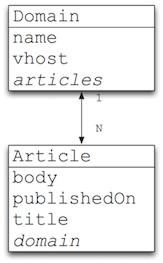
1. Overview
Agrest Protocol is a simple HTTP/JSON-based message protocol. It operates on an object model implicitly shared between a client and a server. It defines the format of JSON documents exchanged between client and server, and a set of control parameters that let the client to control representation of the model returned from the server. E.g. the client may request a range of objects, sorted in a specific order, matching a criteria, with each object including a subset of attributes and related entities. This gives the client exactly what it needs, thus simplifying the code, minimizing the number of trips to the server, and optimizing the size of the response.
application/json is used in both requests and responses where applicable.
Values of some control parameters below are also represented as JSON.
All examples below use an imaginary CMS data model that is made of 2 entities: Domain and Article, with a 1..N relationship between them:
